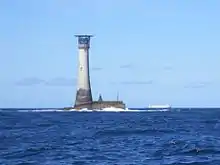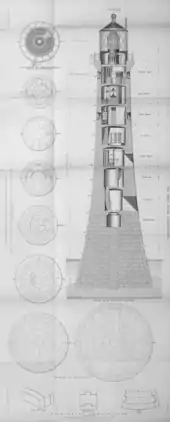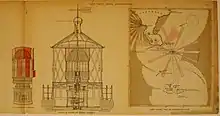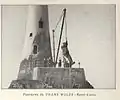Wolf Rock Lighthouse
Wolf Rock Lighthouse is on the Wolf Rock (Cornish: An Welv, meaning the lip),[3] a single rock located 18 nautical miles (33 km; 21 mi) east of St Mary's, Isles of Scilly and 8 nautical miles (15 km; 9.2 mi) southwest of Land's End, in Cornwall, England.[4] The fissures in the rock produce a howling sound in gales, hence the name.[5]
 Wolf Rock Lighthouse | |
 | |

| |
| Location | Land's End Cornwall England |
|---|---|
| Coordinates | 49°56.72′N 05°48.50′W |
| Year first constructed | 1869 |
| Automated | 1988 |
| Foundation | concrete base |
| Construction | granite tower |
| Tower shape | tapered cylindrical tower with lantern and helipad on the top |
| Markings / pattern | unpainted tower, white lantern |
| Tower height | 41 m (135 ft) |
| Focal height | 34 m (112 ft) |
| Original lens | 1st Order catadioptric rotating |
| Current lens | 4th Order ( 250mm) catadioptric rotating |
| Intensity | 17,100 candela |
| Range | 16 nautical miles (30 km; 18 mi) |
| Characteristic | Fl W 15s. |
| Fog signal | 1 blast every 30s. |
| Racon | T |
| Admiralty number | A0030 |
| NGA number | 0028 |
| ARLHS number | ENG 170 |
| Managing agent | Trinity House[1] [2] |
The lighthouse is 41 metres (135 ft) in height and is constructed from Cornish granite prepared at Penzance, on the mainland of Cornwall. It took eight years, from 1861 to 1869, to build due to the treacherous weather conditions that can occur between Cornwall and Scilly.[6] The light can be seen from Land's End by day and night, and lies about one third of the distance from Land's End to the Isles of Scilly. It has a range of 23 nautical miles (43 km; 26 mi) and was automated in 1988. The lighthouse was the first in the world to be fitted with a helipad.[7]
Geology
Situated between Cornwall and the Isles of Scilly, the Wolf Rock is a small plug of phonolitic lava formed during the early part of the Cretaceous period and is unlike any rock exposed on the Cornish mainland.[8]
History

The Gabrielle of Milford Haven was wrecked on the Wolf Rock in 1394. Her cargo, worth £1000, was washed ashore in Cornwall and collected as wreck.[9]
Earlier seamarks
In 1790, the Corporation of Trinity House received a patent of the Crown to build a lighthouse on Wolf Rock. The rights were leased to a Lt. Henry Smith; but (such were the technical challenges of the venture) the project was transferred to the less exposed location of the Longships, where construction of a lighthouse proceeded.[10] On Wolf Rock, rather than a lighthouse, Lt. Smith went on to build a 6.1 m (20 ft) high wrought iron daymark, 10 cm (4 in) in diameter and supported by six stays. A metal effigy of a wolf was placed on top; but by 1795 the daymark was washed away.
In the late 1830s John Thurburn built a beacon, which was completed on 15 July 1840,[11][12] and in November of that year was wrecked by storms when the pole and globe on its top were washed away[13] and not replaced until 1842[14] but they were once more washed away in a storm on 9 October 1844.[15] Trinity House engineer James Walker constructed a 4.3 m (14 ft) high cone-shaped beacon, which took five years to build. Made of iron plates and filled with concrete rubble this was completed in 1848,[16] it can still be seen next to the lighthouse.
Construction of the lighthouse
In April 1860, Trinity House applied to the Board of Trade for funds to build a lighthouse on Wolf Rock.[17] Approval was given and Walker, as engineer-in-chief, drew up designs for a 117 ft (36 m) masonry tower, tapering in diameter from 41 ft 8 in (12.70 m) at the base to 17 ft (5.2 m) at the top. Details of the design followed closely that of other Walker-built lighthouses: the recently completed Bishop Rock and Hanois lights, and the Smalls (which was then nearing completion). While his designs were inspired by Smeaton's third Eddystone Lighthouse, Walker introduced new innovations, not least the use of vertical as well as horizontal dovetail joints (first achieved at Les Hanois at the suggestion of Nicholas Douglass, and likewise incorporated into the design of Wolf Rock).[18]
Nicholas's son James Douglass was appointed as resident engineer, and in July 1861 he arrived (fresh from completing his work as resident engineer for the Smalls lighthouse) and surveyed the rock.[18] The following March work began on excavating the foundations. In October 1862, James Walker died (at the age of 81). James Douglass replaced him as engineer-in-chief to the Trinity House; James's younger brother, William Douglass, then became resident engineer at Wolf Rock.[19]:ch4 William himself laid the first stone of the new tower on 6 August 1864. Masonry construction was completed on 19 July 1869.[20] The finished tower was topped by a lantern storey manufactured by Chance Brothers of Smethwick to James Douglass's design. The lantern had previously been exhibited at the Paris Exhibition of 1867 as an example of the latest in lantern technology, using curved rather than flat panes of glass and helical rather than straight glazing bars.[21]

James Chance of Chance Brothers had designed a large (first-order) rotating multi-panel optic for installation in the tower, 2.58 m (8 ft 6 in) high by 1.73 m (5 ft 8 in) diameter.[22] In order to differentiate the light from the nearby St Agnes lighthouse (which displayed a white light) and from Les Hanois Lighthouse (which displayed a red light) it was resolved that the Wolf Rock light should revolve and flash alternately red and white; in order to achieve the required characteristic it was planned to install 'ruby' coloured panes of glass over half the panels on the optic (with the intervening panels left clear).[23] It was known, however, that the intensity of a light was reduced when shone through coloured glass, so Chance conducted experiments to measure the precise difference.[23] It was concluded that the comparative intensity of clear glass to red was 21 to 9 (i.e. more than double); therefore the red-covered panels on the optic were made wider than the others by the same proportion, in order to maintain an even intensity across the colour-change.
Operational summary
The light first shone in January 1870 and flashed red and white as planned.[24] The completed optic (which together with its pedestal stood 20 feet (6.1 m) high) was described by Douglass as "probably the most perfect for the purpose that has yet been constructed";[25] it continued in use for the next hundred years. The optic was rotated by a clockwork drive, that required winding every four hours.[22] A 7-cwt bell, hung from the lantern gallery, was sounded in fog; driven by a separate clockwork mechanism, it rang three times every fifteen seconds.[26]
The Wolf Rock was the site of a hake (Merluccius merluccius) fishery in the 1870s, especially by fishermen from St Ives with 400 employed in October 1879.[27]
In 1904, a reed fog signal was installed; it remained in use until after the Second World War.[26] (The bell was initially retained for standby use, but was decommissioned in 1906.)[28] In 1955 electrification came to Wolf Rock Lighthouse: a 15 kW tungsten filament lamp was installed in place of the oil lamp, within the old optic, and a set of diesel generators were installed (which powered not only the light but also a new diaphone fog signal).[29] Then, in 1972 Wolf Rock became the first lighthouse in the world to be fitted with a helipad (a smaller fourth-order revolving optic having replaced the original in the meantime);[30] this greatly eased the challenge of getting keepers to and from the lighthouse in heavy seas. The last keepers left Wolf Rock in July 1988, when the lighthouse became fully automated;[5] an electric emitter replaced the diaphone fog signal at this time.[26] Fifteen years later the lighthouse was converted to solar power, with photovoltaic cells being installed around the exterior of the helideck support structure.[22]
Present day
The lighthouse continues in operation; its solar-powered lamp has a range of 16 nautical miles (30 km; 18 mi); it flashes once every 15 seconds and is remotely monitored from the Trinity House Planning Centre in Harwich, Essex.[31]
Popular culture
The Wolf Rock Lighthouse features prominently in the 1925 Dr Thorndyke detective novel, The Shadow of the Wolf, by R. Austin Freeman.[32]
Gallery
_p006_The_Wolf_Rock_Light-house.jpg.webp) Wolf Rock Lighthouse in 1875
Wolf Rock Lighthouse in 1875 Wolf Rock Beacon, 1884, by E. Price Edwards
Wolf Rock Beacon, 1884, by E. Price Edwards A keeper arriving, c. 1913
A keeper arriving, c. 1913 Wolf Rock seen from Land's End
Wolf Rock seen from Land's End
References
- Wolf Rock The Lighthouse Directory. University of North Carolina at Chapel Hill. Retrieved 24 April 2016
- Wolf Rock Lighthouse Trinity House. Retrieved 24 April 2016
- "Cornish Language Partnership: Place names". cornwall.gov.uk. Retrieved 10 July 2019.
- Admiralty Chart 1148: Isles of Scilly to Lands End.
- Jones, Robin (2011). Lighthouses of the South West. Wellington, Somerset: Halsgrove. ISBN 978 0 85704 107 4.
- Rowlett, Russ. "Lighthouses of Southwest England (Devon and Cornwall)". The Lighthouse Directory. University of North Carolina at Chapel Hill. Retrieved 6 July 2015.
- "Trinity House Wolf Rock". www.trinityhouse.co.uk. Corporation of Trinity House. 2014. Retrieved 27 March 2014.
- Hall, Anthony (1994). J T Greensmith (ed.). West Cornwall. Geologists' Association Guide No. 19 (Second ed.). The Geologists' Association. ISBN 0 900717 57 2.
- St Levan Local History Group (2004). The Book of St Levan. Tiverton: Halsgrove. ISBN 1 84114 328 6.
- Nicholson, Christopher P. (1995). Rock Lighthouses of Britain: The End of an Era?. Caithness, Scotland: Whittles. p. 68.
- "Ship News", London Evening Standard, p. 3, 18 July 1840,
PENZANCE, July 16.— The beacon on the Wolf Rock was completed yesterday; it is a cone of 18 feet at the base, and is surmounted by a lantern of six feet in diameter; the total elevation above the surface of the rock Is 46 feet.
- "Penzance", Royal Cornwall Gazette, p. 2, 24 July 1840,
At the close of the proceedings, the Commission having been informed by Mr. Pearce, agent to Lloyds that the exertions of the Trinity Board at the Wolf Rock had been crowned with success in the erection of a cast iron beacon, which had been completed only the preceding night, embarked on board the steamer accompanied by Mr. Pearce, to inspect it, when they expressed their decided approbation of the manner in which the work had been accomplished. The rock was at half tide; and the base of the beacon, which 18 feet in diameter, is about 7 feet above low water, spring tide. It is a cone composed of 10 courses of 2 feet 2 inches and an eleventh coarse of 3 feet, giving about 23 feet perpendicular height - This is surmounted by a strong oak mast of 34 feet, 11 of which are imbedded in the cone A ball of copper hoops, of 6 feet diameter, crowns the whole, giving a total elevation of 53 feet above low water and about 35 feet above high water at spring tides; and although nearly three leagues off, it is distinctly visible from the western land. The Beacon is painted read and white, in horizontal stripes.
- "The Wolfe-Rock", Royal Cornwall Gazette, p. 2, 27 November 1840,
The pole and globe of the beacon on this most dangerous rock, were carried away in the late storms. The conical part of the beacon remains visible above the level of high-water spring-tides; and is supposed to be uninjured.
- "Notice to Mariners", Caledonian Mercury, p. 4, 5 August 1842,
Wolf Rock Beacon - The Pole and Globe of the beacon which were carried away from the beacon upon the Wolf Rock, off the Land's End of Cornwall during the storm in November 1840, have been reinstated
- "NOTICE TO MARINERS.- WOLF ROCK and RUNDLESTONE BEACONS.", Public Ledger and Daily Advertiser, p. 4, 28 October 1844,
TRINITY-HOUSE, London, October 25, 1844. INFORMATION has been received, that in the Storm on the 9th instant the BALLS and upper parts of the wrought IRON MASTS of the WOLF ROCK and RUNDLESTONE BEACONS were BROKEN AWAY. By Order, J. HERBERT, Secretary.
- "THE WOLF-ROCK LIGHTHOUSE", Royal Cornwall Gazette, p. 6, 11 April 1862,
In 1848 this stone beacon was cased outside with thick iron plates (perforated), and a new iron mast and globe erected, with the centre ten feet higher than the former one
- Nicholson, Christopher P. (1995). Rock Lighthouses of Britain: The End of an Era?. Caithness, Scotland: Whittles. pp. 139–145.
- Nancollas, Tom (2018). Seashaken Houses: a Lighthouse History from Eddystone to Fastnet. London: Penguin Random House. p. 139.
- "LIFE OF WILLIAM DOUGLASS M.INST.C.E." (PDF). uslhs.org.
- "THE GREAT WOLF ROCK", Liverpool Mercury, p. 4, 23 July 1869,
On Monday last the last stone of the lighthouse which now surmounts the Wolf Rock was laid by Sir F. Arrow, the deputy master of the Trinity House
- Reports on the Paris Universal Exhibition 1867: Presented to Both Houses of Parliament by Command of Her Majesty. Volume IV. London: Eyre & Spottiswoode. 1868. p. 673.
The chief difference between this lantern and all former ones is that the glass of it, being cylindrically curved, affords the greatest degree of optical accuracy, and the helical steel framing offers the least possible obstruction to the light, it being practically nil.
- Raby, A. C.; Pappas, A.; Dassanayake, D. T.; Brownjohn, J. M. W.; D'Ayala, D.; Antonini, A. "Wolf Rock lighthouse: past developments and future survivability under wave loading". The Royal Society. Retrieved 27 January 2020.
- Chance, James Frederick (1902). The Lighthouse Work of Sir James Chance, Baronet (PDF). London: Smith, Elder & co. Retrieved 24 February 2019.
- "Wreck of a French Brig. A Resolute and Stubborn Frenchman". The Cornishman (45). 22 May 1879. p. 4.
- "The Wolf Rock Lighthouse". Lighthouses of England. Retrieved 5 March 2019.
- Renton, Alan (2001). Lost Sounds: The Story of Coast Fog Signals. Caithness, Scotland: Whittles.
- "St Ives". The Cornishman (65). 9 October 1879. p. 5.
- [https://www.thegazette.co.uk/London/issue/27902/page/2441 London Gazette, Issue 27902, Page 2441, 6 April 1906]
- Woodman, Richard; Wilson, Jane (2002). The Lighthouses of Trinity House. Bradford-on-Avon, Wilts.: Thomas Reed. pp. 183–186.
- "Photograph". Flash (20): 9. Winter 2013. Retrieved 21 March 2019.
- "Wolf Rock Lighthouse". Trinity House. Retrieved 11 February 2020.
- Work available at Project Gutenberg Australia (retrieved 12/03/2014)
External links
| Wikimedia Commons has media related to Wolf Rock Lighthouse. |
- Wolf Rock Lighthouse at Trinity House
- The Shadow of the Wolf at Gutenberg Australia
- Minutes of the Proceedings of the Institute of Civil Engineers, Vol. XXX, Session 1869-70, Part II (Douglass's detailed description of the design and building of the lighthouse)